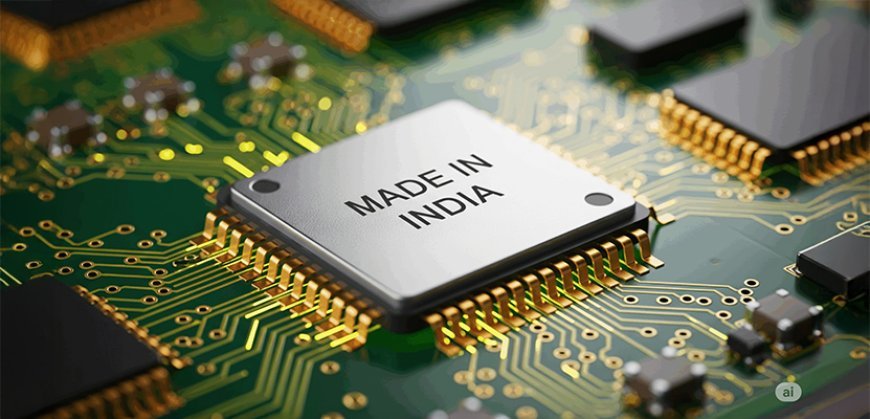From Outsider to Power Player, How India’s Chip Dream Is Becoming Reality
Can India’s bold semiconductor mission make it the next global chip powerhouse? Discover how it’s reshaping the world’s tech future.

India is moving from a chips-importing market to a strategically placed node in design, packaging, and eventually mature-node fabrication, reshaping supply-chain optionality for the U.S., Taiwan, and allied ecosystems while diversifying risk away from East Asia chokepoints.
Policy backbone
- The India Semiconductor Mission provides up to 50% capex support for fabs, plus schemes for compound semiconductors, OSAT/ATMP, displays, and a dedicated Design Linked Incentive program—anchoring a multi-segment strategy rather than a single-fab bet.
- The government’s ₹76,000 crore semicon package (with Semicon “2.0” in discussion) complements broader PLI-led electronics growth, aligning policy continuity with downstream demand from mobile and IT hardware manufacturing.
Market momentum
- India’s chip market was about US$38 billion in 2023 and is projected to reach US$45–50 billion by 2025 and US$100–110 billion by 2030, creating local anchor demand for packaging and mature-node production that strengthens case economics for new capacity.
- This demand sits within a global semiconductor market targeting US$1 trillion by 2030, positioning India to capture share across design, OSAT, and selected process nodes as projects come online.
Capacity being built

- Micron’s ATMP/OSAT project in Sanand, Gujarat—supported by substantial central and state incentives—targets DRAM/NAND packaging largely for export, providing India with near-term supply-chain relevance and workforce upskilling.
- Additional OSAT and specialty-semiconductor facilities have been approved across multiple states, expanding geographic clusters and supplier bases that are essential for ecosystem density and resilience.
Key partnerships
- Micron’s packaging project with Tata Projects for build and ramp underscores a U.S.–India pipeline linking memory supply to diversified assembly/test footprints.
- Foxconn, after exiting the Vedanta JV, has reoriented toward OSAT and potential mature-node lines with new Indian partners; such modular steps align with India’s practical first phase of assembly/test and legacy nodes before pursuing advanced processes.
- Reported Tata–PSMC collaboration for a 28 nm fab highlights a foundry knowledge-transfer pathway that could seed mature-node logic supply for automotive and industrial demand.
What shifts in global dynamics
- Risk diversification: New OSAT and mature-node capacity in India provides alternative routing for memory and controller packaging, easing single-region exposure in Taiwan and China during demand surges or geopolitical disruptions.
- Value-chain rebalancing: With incentives de-risking capex and a fast-growing end market, suppliers can colocate test, assembly, and eventually wafer capacity closer to downstream electronics, tightening lead times for India, Middle East, and Africa corridors.
- Standards and alliances: U.S.–India collaboration, Taiwanese partnerships, and Europe-Japan supplier interest create a multi-ally architecture that complements CHIPS Act hubs while broadening equipment, materials, and services flows.
Competencies first, then nodes
- India’s phased path includes design enablement, OSAT scale, compound semiconductors, and mature-node CMOS, prioritizing segments with faster time-to-value and workforce absorption before attempting leading-edge EUV-based fabs.
- The DLI scheme and “Chips to Startups” pipeline focus on EDA access, IP development, and design commercialization, seeding domestic firms and talent that ultimately raise the ceiling for future process-node ambitions.
Bottlenecks and execution risks

- Technology access: Securing sustained partnerships for process recipes, tool integration, and yield learning curves remains critical; Foxconn–Vedanta’s unwind shows partnership durability matters as much as capital.
- Cluster depth: Building reliable local supplier tiers for gases, chemicals, ultrapure water, power quality, and maintenance services is a multi-year journey, with progress tied to state-level execution.
- Talent scale-up: Packaging ramps first, but advanced fab operations require thousands of specialized engineers and technicians; training programs and international rotations must keep pace with project approvals.
Near-term outlook
- 2025–2027 will likely see India consolidate OSAT output and pilot mature-node runs, integrate more suppliers into Sanand and other clusters, and expand approved projects to commissioning, incrementally lifting global capacity for legacy nodes and memory packaging.
- As clusters mature, India becomes a credible second-source location for automotive, industrial, and IoT semiconductors, easing backlogs in cyclical tightness and improving bargaining leverage across OEM supply strategies.
FAQs
What is India’s semiconductor strategy?
India’s semiconductor strategy aims to build a complete chip manufacturing ecosystem, from design and fabrication to testing and packaging. The government launched the ₹76,000 crore Semicon India Program to attract global investors, strengthen supply chains, and reduce import dependence.
Why are semiconductors so important for India’s economy?
Semiconductors are critical for electronics, automobiles, defense, and AI technologies. Developing this industry can boost India’s manufacturing base, create skilled jobs, and position the country as a global technology hub.
Which companies are investing in India’s semiconductor sector?
Major players include Micron, which is setting up a chip assembly and test facility in Gujarat, Tata Electronics working on semiconductor packaging, and Vedanta-Foxconn exploring fabrication partnerships. Several startups are also entering chip design through government incentives.
What role does the government play in India’s chip manufacturing plans?
The Indian government provides financial incentives, policy support, and infrastructure development through the Semicon India Program and the Design Linked Incentive (DLI) Scheme. These initiatives aim to make India globally competitive in semiconductor production.
How does India’s semiconductor growth impact global supply chains?
India’s entry helps diversify supply chains traditionally dominated by Taiwan and China. As global powers look to reduce dependence on a few regions, India’s participation brings stability, transparency, and a “friendshoring” alternative for chip manufacturing.

 Admin
Admin